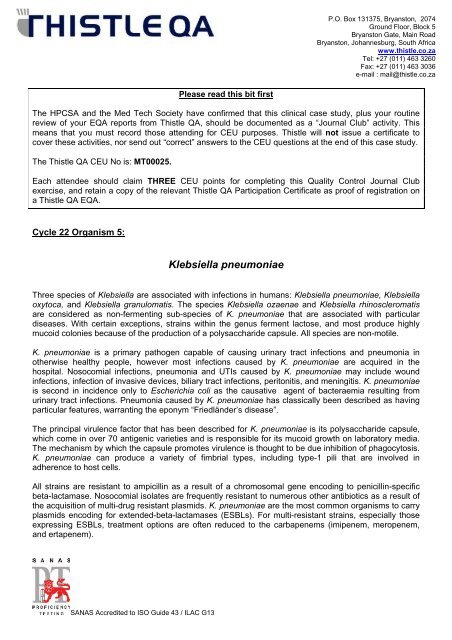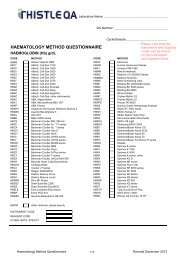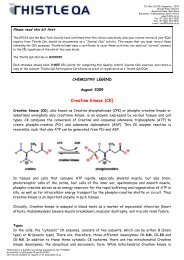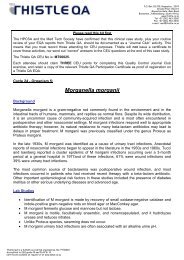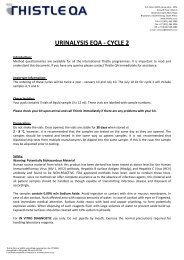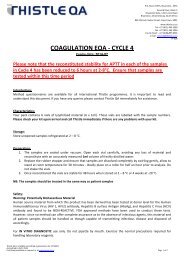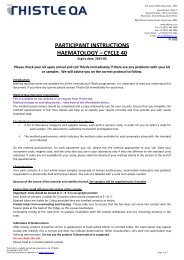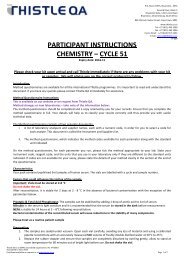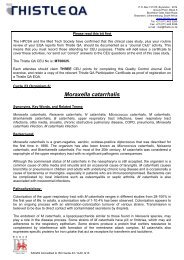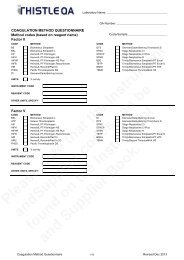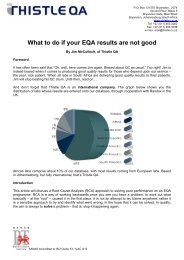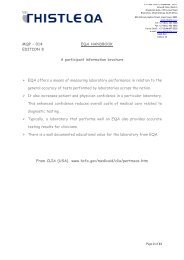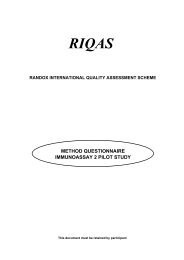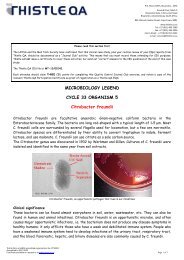Klebsiella pneumoniae - Thistle QA
Klebsiella pneumoniae - Thistle QA
Klebsiella pneumoniae - Thistle QA
- No tags were found...
Create successful ePaper yourself
Turn your PDF publications into a flip-book with our unique Google optimized e-Paper software.
P.O. Box 131375, Bryanston, 2074<br />
Ground Floor, Block 5<br />
Bryanston Gate, Main Road<br />
Bryanston, Johannesburg, South Africa<br />
www.thistle.co.za<br />
Tel: +27 (011) 463 3260<br />
Fax: +27 (011) 463 3036<br />
e-mail : mail@thistle.co.za<br />
Please read this bit first<br />
The HPCSA and the Med Tech Society have confirmed that this clinical case study, plus your routine<br />
review of your E<strong>QA</strong> reports from <strong>Thistle</strong> <strong>QA</strong>, should be documented as a “Journal Club” activity. This<br />
means that you must record those attending for CEU purposes. <strong>Thistle</strong> will not issue a certificate to<br />
cover these activities, nor send out “correct” answers to the CEU questions at the end of this case study.<br />
The <strong>Thistle</strong> <strong>QA</strong> CEU No is: MT00025.<br />
Each attendee should claim THREE CEU points for completing this Quality Control Journal Club<br />
exercise, and retain a copy of the relevant <strong>Thistle</strong> <strong>QA</strong> Participation Certificate as proof of registration on<br />
a <strong>Thistle</strong> <strong>QA</strong> E<strong>QA</strong>.<br />
Cycle 22 Organism 5:<br />
<strong>Klebsiella</strong> <strong>pneumoniae</strong><br />
Three species of <strong>Klebsiella</strong> are associated with infections in humans: <strong>Klebsiella</strong> <strong>pneumoniae</strong>, <strong>Klebsiella</strong><br />
oxytoca, and <strong>Klebsiella</strong> granulomatis. The species <strong>Klebsiella</strong> ozaenae and <strong>Klebsiella</strong> rhinoscleromatis<br />
are considered as non-fermenting sub-species of K. <strong>pneumoniae</strong> that are associated with particular<br />
diseases. With certain exceptions, strains within the genus ferment lactose, and most produce highly<br />
mucoid colonies because of the production of a polysaccharide capsule. All species are non-motile.<br />
K. <strong>pneumoniae</strong> is a primary pathogen capable of causing urinary tract infections and pneumonia in<br />
otherwise healthy people, however most infections caused by K. <strong>pneumoniae</strong> are acquired in the<br />
hospital. Nosocomial infections, pneumonia and UTIs caused by K. <strong>pneumoniae</strong> may include wound<br />
infections, infection of invasive devices, biliary tract infections, peritonitis, and meningitis. K. <strong>pneumoniae</strong><br />
is second in incidence only to Escherichia coli as the causative agent of bacteraemia resulting from<br />
urinary tract infections. Pneumonia caused by K. <strong>pneumoniae</strong> has classically been described as having<br />
particular features, warranting the eponym “Friedländer’s disease”.<br />
The principal virulence factor that has been described for K. <strong>pneumoniae</strong> is its polysaccharide capsule,<br />
which come in over 70 antigenic varieties and is responsible for its mucoid growth on laboratory media.<br />
The mechanism by which the capsule promotes virulence is thought to be due inhibition of phagocytosis.<br />
K. <strong>pneumoniae</strong> can produce a variety of fimbrial types, including type-1 pili that are involved in<br />
adherence to host cells.<br />
All strains are resistant to ampicillin as a result of a chromosomal gene encoding to penicillin-specific<br />
beta-lactamase. Nosocomial isolates are frequently resistant to numerous other antibiotics as a result of<br />
the acquisition of multi-drug resistant plasmids. K. <strong>pneumoniae</strong> are the most common organisms to carry<br />
plasmids encoding for extended-beta-lactamases (ESBLs). For multi-resistant strains, especially those<br />
expressing ESBLs, treatment options are often reduced to the carbapenems (imipenem, meropenem,<br />
and ertapenem).<br />
SANAS Accredited to ISO Guide 43 / ILAC G13
Questions:<br />
1. How will you isolate and identify a K. <strong>pneumoniae</strong><br />
2. What types of infections are caused by K. <strong>pneumoniae</strong><br />
3. What are the recommended antimicrobial agents used to treat K. <strong>pneumoniae</strong> infections,<br />
especially the strains that produce ESBLs<br />
SANAS Accredited to ISO Guide 43 / ILAC G13


